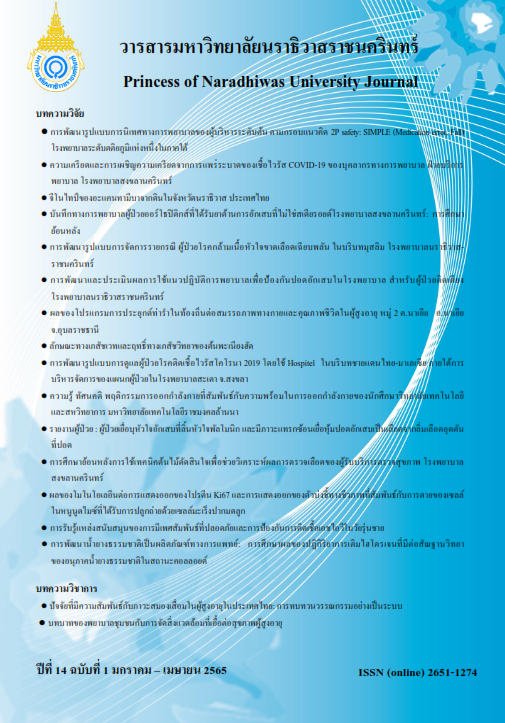Pharmacognostic Character and Pharmacological Properties of Elaeodendron glaucum (Rottb.) Pers.
Keywords:
Elaeodendron glaucum (Rottb.), Pers, Pharmacognosy, Pharmacological activityAbstract
Elaeodendron glaucum (Rottb.) Pers. is an indigenous herb belonging to the Celastraceae family. Its bark has been used to treat diabetic wounds according to the folk wisdom of Isan healers and is still being used for continuous healing. The purpose of this research was to study the pharmacognostic character of this plant by studying the macroscopic and microscopic characteristics of the drug, the physicochemical characterization and the chemical identification by high-performance liquid chromatography (HPLC). In addition, the pharmacological effects of its bark were also studied, including antioxidant, anti-inflammatory, and antibacterial activities. The results showed that the bark was reddish-brown, the loss on drying (2.17 ± 0.05 %w/w), total ash (13.97 ± 0.03 %w/w), acid-insoluble ash (0.41 ± 0.11 %w/w), water extractive (13.89 ± 0.20 %w/w) and ethanol extractive values (16.48 ± 0.25 %w/w). Phytochemical studies have shown that the bark extraction of this herb contains flavonoids, tannins and alkaloids. Gallic acid and vanillin were also found as important constituents. Moreover, the aqueous extract of the bark exhibited antioxidant activity (EC50 was 5.50 ± 0.10 and 25.28 ± 0.63 µg/ml when tested by DPPH and ABTS, respectively), anti-inflammatory effect by inhibiting nitric oxide secretion (EC50 was 157.60 ± 1.25 µg/ml), and also revealed antibacterial activity. The results of this study are very useful in the quality control of herbs and are important information to support the use of E. glaucum according to folk wisdom. The finding also helps to expand knowledge in herbal medicine product development.
References
Alqethami, A., & Aldhebiani, A. (2021). Medicinal plants used in Jeddah, Saudi Arabia: Phytochemical screening. Saudi Journal of Biological Sciences, 28(1) 805-812.
Biswas, S., Das, R., & Ray-Banerjee, E. (2017). Role of free radicals in human inflammatory diseases. AIMS Biophysics, 4(4), 596-614.
Chuangchot, C., Tattawasart, U., Sripanidkulchai, B., Junlatat, J. & Fangkrathok, N. (2017). Antibacterial and antioxidant activity of Rafflesia kerrii extract against multidrug-resistant bacteria. Songklanakarin Journal of Science and Technology, 39(2), 163-170.
Denchai, R., Rattarom, R., & Nualkeaw, S. (2018). Species Identification of Crude Drug Under the Thai Name of “Thian Klaep” and Specification of Malted Barley. Isan Journal of Pharmaceutical Sciences, 14(3), 154-164.
Department of Medical Sciences. (2019). Thai Herbal Pharmacopoeia 2019. (Volum I). Bangkok. Prachachon Co.,Ltd. (in Thai)
Fangkrathok, N., Sripanidkulchai, K., Junlatat, J. & Sripanidkulchai, B. (2021). Bioactivities of Lentinus polychrous and Ganoderma lucidum (Agaricomycetes) polysaccharide extracts. International Journal of Medicinal Mushrooms, 23(7), 51-61.
Javaweera, D.M. (2006) Medicinal Plants (Indigenous and exotic) Used in Ceylon. Part II CA. Sri Lanka: The National Science Foundation, 24-26.
Junlatat, J., Fangkrathok, N., & Sripanidkulchai, B. (2018). Antioxidative and melanin production inhibitory effects of Syzygium cumini extracts. Songklanakarin Journal of Science and Technology, 40(5), 1136-1143.
Junlatat, J., Peng-ngummuang, K., Tuseewan, M., Thorajake, P., Opap, P., Kumpapong, S., Konkhayan, S., & Fangkrathok, N. (2020). In vitro anti-oxidant, anti-inflammatory and anti-microbial properties of local herbal recipe for diabetic ulcer treatment. Interprofessional Journal of Health Sciences, 18(2), 44-50.
Khan, A. & Junaid, N. (2017). Prevalence of diabetic foot syndrome amongst population with type 2 diabetes in Pakistan in primary care settings. Journal of Pakistan Medical Association, 67(12), 1818-1824.
Kumar, R., & Saikia P. (2020). Wild edible plants of Jharkhand and their utilitarian perspectives. Indian Journal Tradittional Knowledge, 19(2), 237-250.
Kumari, S.J., Sangeetha, M., & Ali, S. (2018). Formulation and evaluation of herbal gel from tannin-enriched fraction of Psidium guajava Linn. Leaves for diabetic wound healing. International Journal of Green Pharmacy, 12(3)(Suppl), S490-S496.
Meeyutem, P., Prachasupap, A., Chotpool, K., Tumpad, A., & Chansukh, K.K. (2019). Macroscopical and microscopical characteristics of Thai crude drugs under the name of Kaen-Kankrao. Jounal of Allied Health Sciences Suan Sunandha Rajabhat University, 4(1), 34-40.
Momtaz, S., Dibaj, M., Abdollahi, A., Amin, G., Bahramsoltani, R., Abdollahi, M., …, & Abdolghaffari, A.H. (2020). Wound healing activity of the flowers of Lilium candidum L. in burn wound model in rats. Journal of Medicinal Plants, 19(73), 109-118.
Punthawongkoon, C., Thuseewan, M., Pumthong, G., Nontapot, S., Sooktho, S., Junlathat, J., … & Tienthongin, P. (2015). Indigenous wisdom of folk medical doctors living in Ubonratchathani. Ubonratchani: Withayakarnpim, (in Thai)
Sridhar, K., & Charles, A.L. (2019). In vitro antioxidant activity of Kyoho grape extracts in DPPH and ABTS assays: Estimation method for EC50 using advanced statistical programs. Food Chemistry, 275(1), 41-49.
Sripanidkulchai, B. & Junlatat, J. (2014). Bioactivities of alcohol based extracts of Phyllanthus emblica branches: antioxidation, antimelanogenesis and anti-inflammation. Journal of Natural Medicine, 68, 615-622.
Su, X., Liu, X., Wang, S., Li, B., Pan, T. & Liu, D., … , & Li, K. (2016). Wound-healing promoting effect of total tannins from Entada phaseoloides (L.) Merr. in rats. Burns, 43(4), 830–838.
Tavares, E.A., Pontes, T.P., Barbosa, M.M., Araújo, A.A., Araújo, R.F., Figueiredo, J.G., …, & Medeiros, A.C. (2018). Chitosan membrane modified with a new zinc (II)-vanillin complex improves skin wound healing in diabetic rats. Frontiers in Pharmacology, 9, 1511.
Yang, D.J., Moh, S.H., Son, D.H., You, S., Kinyua, A.W., Ko, C.M., …, & Kim, K.W. (2016). Gallic acid promotes wound healing in normal and hyperglucidic conditions. Molecules, 21(7), 899.
Additional Files
Published
How to Cite
Issue
Section
License
Copyright (c) 2022 Princess of Naradhiwas University Journal

This work is licensed under a Creative Commons Attribution-NonCommercial-NoDerivatives 4.0 International License.




